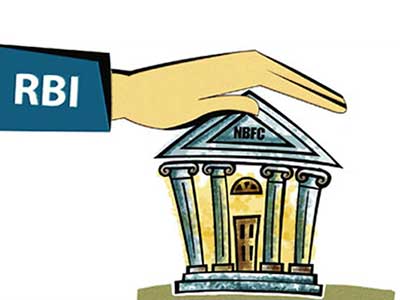GS-3: Indian Economy and issues relating to Planning, Mobilization of Resources, Growth, Development and Employment.
Key phrases: NBFC, PCA
Why in news:
RBI brings PCA to better control NBFCs
Analysis:
What are NBFCs?
- Non-Banking Financial Company (NBFC) is a company registered under the Companies Act, 1956 engaged in the business of loans and advances, acquisition of shares/stocks/bonds/debentures/securities issued by Government or local authority
- Do not include any institution whose principal business is that of agriculture activity, industrial activity, purchase or sale of any goods (other than securities) or providing any services and sale/purchase/construction of immovable property.
- NBFCs do not form part of the payment and settlement system and cannot issue cheques drawn on itself.
- NBFCs cannot accept demand deposits.
- Deposit insurance facility of Deposit Insurance and Credit Guarantee Corporation is not available to depositors of NBFCs.
Working of NBFCs
- In India NBFCs, typically, lend at high interest rates, by sourcing funds from commercial banks.
- They borrow through money market instruments such as Commercial Paper for cost effectiveness and keep rolling them over to fund their long-term loan assets, thereby facing asset-liability mismatches apart from liquidity and re-pricing risks.
What is PCA?
- The Prompt Corrective Action (PCA) framework is aimed at nursing a lender facing issues on the asset quality, profitability and capital fronts back to health.
- To prevent shocks from spreading in the financial system and preserve financial stability, the Reserve Bank of India (RBI) intervenes when a lender shows signs of distress by invoking PCA.
- RBI puts a Bank under PCA if the breach any one of the three risk thresholds under the three indicators that it tracks -- capital, asset quality and leverage.
- Under PCA, RBI asks a lender to take corrective actions, including preparing a time bound plan for reduction of bad loans; make higher provisions for bad loans/ investments; restrict/ reduce credit for borrowers below certain rating grades and restrict/reduce unsecured exposures etc.
What is the new PCA framework about?
- Framework will apply to all deposit-taking NBFCs, all non-deposit taking NBFCs in the middle, upper and top layers, including investment and credit firms, core investment firms, infrastructure debt funds.
- It has excluded NBFCs not accepting or not intending to accept public funds, primary dealers and housing finance firms, along with government-owned ones.
Importance of NBFCs
- Non-bank entities with specialised expertise provide an alternative source of credit and certain functions in the credit intermediation chain more cost-efficiently.
- These companies played a critical role in the core development of infrastructure, transport, and employment generation.
- Crucial role in the banking sector by increasing the penetration of financial products to unbanked areas.
- NBFC sector has seen tremendous growth. For instance, in last five years alone, size of balance sheet of NBFCs has more than doubled from Rs 20.72 lakh crore (2015) to Rs 49.22 lakh crore (2020)-9600 NBFCs in India.
Issues facing NBFCs and why PCA was required
- NBFCs like Infrastructure Leasing & Financial Services (IL&FS) and Dewan Housing Finance Ltd (DHFL) failed primarily due to lack of corporate governance and non-disclosure of possible NPAs.
- High NPAs: Post demonetisation in 2016, banks had abundant liquidity. NBFC’s credit growth had been lacklustre mainly due to higher NPAs followed by Covid-19 pandemic conditions.Some public sector banks were put under the RBI’s Prompt Corrective Action framework, which restricted growth of their business.
- Bubble formation: Some NBFCs capitalised on this opportunity and expanded their balance-sheet size rapidly. In the process, NBFCs ended up giving loans to non-creditworthy/non-investment grade borrowers.
- The liquidity squeeze faced by NBFCs has led to a conflict between the government and the Reserve Bank of India, with the Finance Ministry pushing for easier fund flows while the RBI insists there’s enough money available in the system.
- There are rising fears that the funding cost for NBFCs will zoom and result in a sharp decline in their margins.
- GNPA ratio of NBFC sector deteriorated to 6.5 per cent as in December 2018 from 6.1 per cent in March 2018.
Efforts undertaken by government
- RBI brings NBFCs under Prompt Corrective Action (PCA)
- RBI - Creation of four-layer regulatory framework by degree of regulation in each sector is proportional to the perception of risk in that sector
- Under Atmanirbhar scheme-to increase liquidity government will pick up investment grade debt papers with guarantees-will increase lending to NBFCs- improve confidence crisis in debt market
- NBFCs which do public placement of debt have to maintain a Debenture Redemption Reserve (DRR) and, in addition, a special reserve, as required by RBI
Way ahead
- Efficient engagement of customers: NBFCs must distinguish between active and inactive customers to develop a focused engagement methodology and allocate resources efficiently.
- A concerted effort across stakeholders is required to prevent a market contagion that can cut off the critical supply of capital to the grassroots of the nation.
- The RBI has to work on multiple lending, over-indebtedness of the borrowers and coercive recovery practices of NBFCs.
- Turning into full-fledged universal banks: It may be a good idea if NBFCs (endowed with better loan origination capability and lower operating cost model) and banks (with deep pockets) opt for co-lending in respect of priority sector loans.
Source: The Hindu









